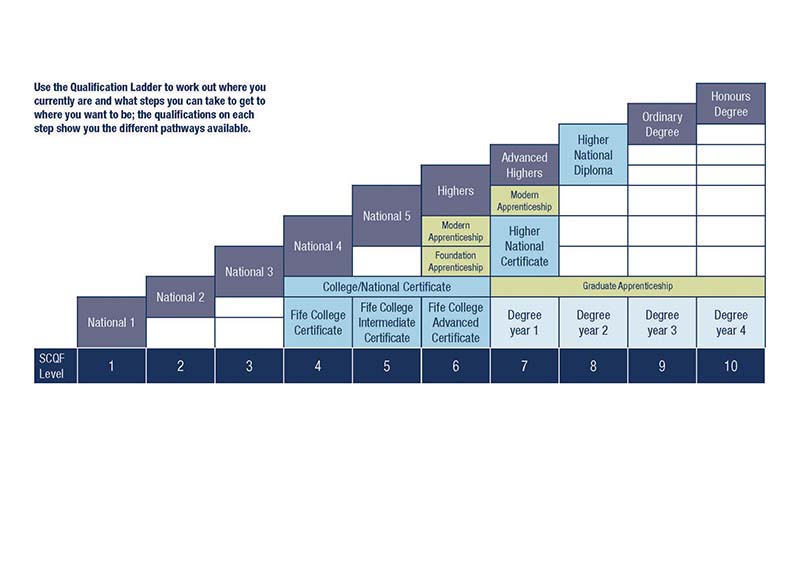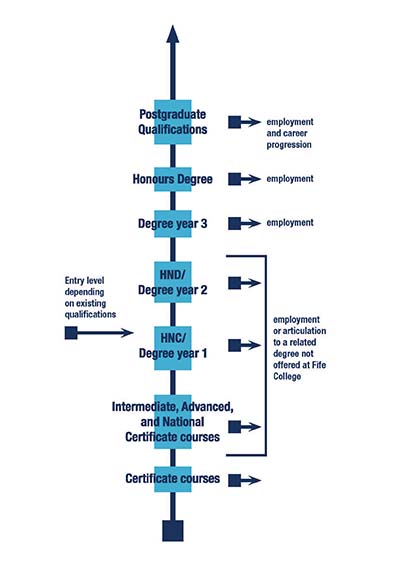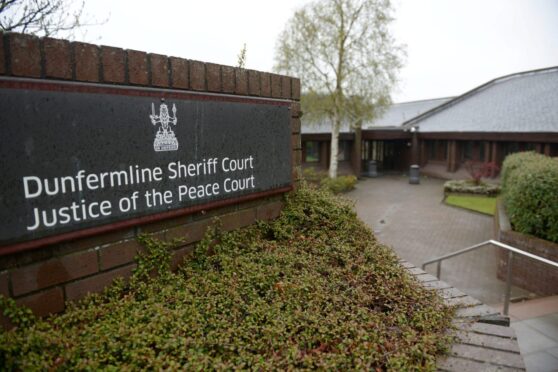Whether you are a parent or carer of a child choosing subjects at school or someone looking to upskill or retrain, you may be finding the range of qualifications available confusing. If that sounds like you – don’t worry, Fife College is here to help.
In recent years, there have been many changes to the range of qualifications – this is fantastic news as it gives everyone more choice and more opportunities to reach their goal. It can, however, seem complicated – especially if you’ve not been in the world of education for a while.
Here is a list of the main qualifications you may come across in Scotland:
- Access courses – Fife College offers a range of access courses for those leaving school with few qualifications – they can also be the perfect choice for those returning to study.
- National 1-5, Highers, Advanced Highers and Scottish Baccalaureates – these are normally studied at school. Fife College also offers some National 5 and Higher level courses.
- Foundation Apprenticeships – these are work based qualifications for secondary school pupils in S5. Fife College offers 11 different Foundation Apprenticeships in partnership with Fife Council.
- Skills for Work combine study in school or college with learning at work.
National Certificates (NC) are normally studied at college and National Qualifications (NQ) are qualifications you normally study at school. - Scottish Vocational Qualifications (SVQ) – these include work-based learning. For example, if you’re doing a Modern Apprenticeship you could achieve an SVQ.
- SQA Wider Achievement awards – these recognise the life and work skills that learners have gained.
- Scottish Wider Access Programme (SWAP) – offered at college to support adult learners to access Higher Education study at college and universities.
- Higher National Certificates (HNC) and Higher National Diplomas (HND) which are usually studied at college. A HNC and HND is equivalent to the first two years of a degree course.
- Degrees, Masters Degrees and PhDs are usually studied at university, but some colleges including Fife, offer degree courses in partnership with universities.
- Professional Apprenticeships and Modern Apprenticeships (MAs) – you would complete through work and may attend college part-time.
- Graduate Apprenticeships – provide an alternative route to achieve a degree qualification whilst in employment.
SCQF Levels
The Scottish Credit and Qualifications Framework (SCQF) is made up of 12 levels – the different levels indicate the level of difficulty of a particular qualification with each qualification being allocated at a level on the SCQF.
At Fife College, qualifications go up to SCQF Level 10 – use the qualification ladder below to work out where you are at and the steps you need to take to get to where you want to be.

The college’s prospectus and website also have useful career planner maps for each subject area which show at a glance the pathway to take to progress.
Foundation Apprenticeships
You may have heard this being mentioned in adverts and in the news recently as the Scottish Government’s ambition is to offer 5,000 Foundation Apprenticeship opportunities over the next year which means more chances than ever before for pupils to benefit from work-based learning. This qualification is a SCQF Level 6, which is the same level as a Higher.
Foundation Apprenticeships are open to pupils in S5 and enable young people to kick start their career while still at school. This innovative career pathway allows pupils to learn the skills that employers want and need whilst they pick up real life work experience with an employer. This is a fantastic qualification to have on a CV and for future college, university and job applications.
Did you know…
You can study the first one or two years of your degree at Fife College before progressing to university?
Unlike going straight to university from school, studying an HNC and/or HND at college means that you finish each year with a recognised qualification, studying for your HNC/D at college gives you more options than going straight to university.
Take a look at Fife College’s handy diagram which shows how you can progress at college from one level to the next.

Still not sure?
This will hopefully have made things a little clearer, but if you still have some questions the Guidance and Attendance teams are available across all five Fife College campuses.
To make an appointment, pop by any campus reception or email guidance@fife.ac.uk.
Further information can be found on the Qualifications Explained pages on the Fife College website.










